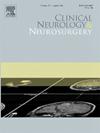Characteristics and therapeutic profile of the patients with upper cervical spinal cord ependymoma from the medulla oblongata to C4: A cohort of 108 cases
IF 1.8
4区 医学
Q3 CLINICAL NEUROLOGY
引用次数: 0
Abstract
Background
Upper cervical spinal ependymomas (uCSE) is routinely identified as intramedullary ependymomas located from the oblongata medulla to C4 level. Our study aimed to report the outcomes and treatment profiles of uCSE from our cohort of uCSE patients.
Methods
This retrospective observational study included 108 patients with upper cervical spinal ependymomas (uCSE) who underwent surgery at Huashan Hospital from 2008 to 2022. Demographic and clinical data were collected to identify risk factors may associated with post-operative spinal cord function, quality of life and respiratory function.
Results
The mean age of included patients was 44.30 ± 12.71 years old. The most common uCSE was ependymoma (103 of 108, 95.37 %), followed by subependymoma (3 of 108, 2.78 %) and anaplastic Ependymoma (2 of 108, 1.85 %). Age (P = 0.003), sex (P = 0.004), duration of symptoms (P = 0.010), pre-operative bladder functions (P = 0.012), post-operative pneumonia (P = 0.013) and Carbon Dioxide Retention (CDR) (P = 0.004) could independently correlate with Iiving quality of uCSE patients. Post-operative spinal cord function was associated with pneumonia immediately after operation (P = 0.017). In addition, post-operative pneumonia correlated with tumor location (P = 0.048), pre-operative McCormick scores (P = 0.008)/ motor functions (P = 0.022)/ NRS scores (P = 0.020), and tracheotomy immediately after operation (P < 0.001). Tracheotomy immediately after operation was associated with tumor location (P = 0.023), unsteady walking (P = 0.033), pre-operative NRS scores (P = 0.029), post-operative pneumonia (P < 0.001) and CDR (P < 0.001).
Conclusion
Within uCSE patients, post-operative quality of life is associated with pre-operative spinal cord function and symptom duration, which emphasizing the importance of early intervention. Their post-operative respiratory dysfunctions also correlated with post-operative spinal cord function and quality of life.
求助全文
约1分钟内获得全文
求助全文
来源期刊

Clinical Neurology and Neurosurgery
医学-临床神经学
CiteScore
3.70
自引率
5.30%
发文量
358
审稿时长
46 days
期刊介绍:
Clinical Neurology and Neurosurgery is devoted to publishing papers and reports on the clinical aspects of neurology and neurosurgery. It is an international forum for papers of high scientific standard that are of interest to Neurologists and Neurosurgeons world-wide.
 求助内容:
求助内容: 应助结果提醒方式:
应助结果提醒方式:


